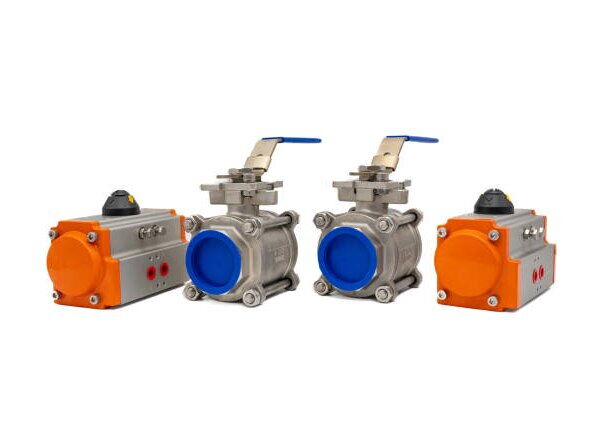Pneumatic actuators are essential mechanical devices used in various industrial applications to automate the operation of valves, dampers, and other control mechanisms. By converting compressed air energy into linear or rotary motion, these actuators provide efficient and reliable performance in process control systems.
Proper installation is critical to ensuring optimal functionality, longevity, and safety. This guide provides a step-by-step approach to installing pneumatic actuators, covering preparation, mounting, connection, testing, and troubleshooting.

Before diving into installation, it’s important to understand the types of pneumatic actuators and their applications:
Used for ball valves, butterfly valves, and plug valves, providing 90-degree rotational movement.
Employed in gate valves and globe valves, converting air pressure into straight-line motion.
Utilize a gear mechanism to produce rotary motion.
Ideal for high-torque applications, often used in large industrial valves.
This guide focuses primarily on quarter-turn pneumatic actuators, one of the most common types used in industrial settings.
Before starting, ensure you have the following:
Wrenches (adjustable, socket, or spanner)
Screwdrivers (flathead and Phillips)
Thread sealant (Teflon tape or liquid thread sealant)
Torque wrench (for precise bolt tightening)
Alignment tools (if required)
Safety gear (gloves, goggles, and protective clothing)
Ensure the actuator matches the valve’s specifications (torque, size, and mounting pattern).
Check the valve’s shaft type (square, round, keyed, or splined) to confirm compatibility with the actuator.
Depressurize the system – Shut off and lock out the compressed air supply.
Isolate the valve – Ensure the valve is not under pressure or handling hazardous fluids during installation.
Review manufacturer instructions – Follow specific guidelines provided by the actuator and valve manufacturers.
Before installation, conduct a thorough inspection:
Actuator – Check for shipping damage, such as dents, cracks, or bent shafts.
Valve – Ensure the valve’s sealing surfaces are clean and undamaged.
Mounting hardware – Verify that bolts, washers, and couplings are in good condition.
Align the Actuator with the Valve
Position the actuator over the valve, ensuring the mounting holes align correctly.
For ISO-standard actuators, ensure proper flange alignment (ISO 5211 mounting pad).
Secure the Actuator
Insert mounting bolts and washers, tightening them evenly in a criss-cross pattern.
Use a torque wrench to apply the manufacturer-recommended torque settings (over-tightening can damage the actuator or valve).
Keyed Shafts – Slide the actuator onto the valve shaft, ensuring the keyway is properly seated.
Spline Shafts – Align the splines before securing the actuator.
Set-Screw or Clamp Couplings – Tighten the set-screws or clamping mechanism to prevent slippage.
Identify Air Ports
Most actuators have two ports: one for opening (extend) and one for closing (retract).
Double-acting actuators require air supply to both ports, while single-acting actuators use a spring return.
Connect Air Lines
Use appropriate fittings (NPT, BSP, or metric threads).
Apply thread sealant to prevent air leaks (avoid over-tightening to prevent thread damage).
Install Air Filter/Regulator/Lubricator (FRL) Unit (if applicable)
Ensures clean, dry, and properly pressurized air supply.
If the actuator includes position sensors or solenoid valves:
Follow the manufacturer’s wiring diagram.
Ensure proper grounding to prevent electrical interference.
Test signal communication with the control system.
Visual Inspection – Confirm all bolts, fittings, and connections are secure.
Manual Override Test – Engage the manual override (if available) to check smooth operation.
Slowly Introduce Air Pressure
Gradually increase pressure to avoid sudden movements.
Observe the actuator’s movement (should be smooth without jerking).
Cycle Testing
Open and close the valve multiple times to ensure consistent operation.
Check for air leaks at connections (listen for hissing sounds).
Position Verification
Ensure the valve reaches full open and closed positions.
Adjust limit switches (if equipped) to fine-tune travel stops.
Speed Control – Install flow control valves to adjust actuator speed.
Torque Adjustment – Some actuators allow spring preload adjustments for optimal torque.
|
Issue |
Possible Cause |
Solution |
|
Actuator not moving |
No air supply, blocked ports |
Check air lines, clear obstructions |
|
Slow operation |
Low air pressure, restricted flow |
Adjust regulator, check for leaks |
|
Air leaks |
Loose fittings, damaged seals |
Tighten connections, replace seals |
|
Valve not fully closing |
Misaligned shaft, incorrect limit setting |
Realign shaft, adjust limit switches |
|
Excessive vibration |
Unbalanced load, high speed |
Install dampers, adjust flow control |
To ensure long-term reliability:
Regular Lubrication – Follow manufacturer guidelines for greasing moving parts.
Periodic Leak Checks – Inspect air lines and fittings for wear.
Calibration – Recheck limit switches and sensors annually.
Proper installation of pneumatic actuators is crucial for efficient valve operation and system longevity. By following this comprehensive guide—covering preparation, mounting, pneumatic connections, testing, and troubleshooting—you can ensure a smooth and successful installation process.
For complex systems, always refer to the manufacturer’s documentation and consult with engineering specialists when necessary. A well-installed pneumatic actuator enhances process efficiency, reduces downtime, and ensures safe operation in industrial environments.
Final Tip: Document the installation process, including torque settings and adjustments, for future maintenance reference.
